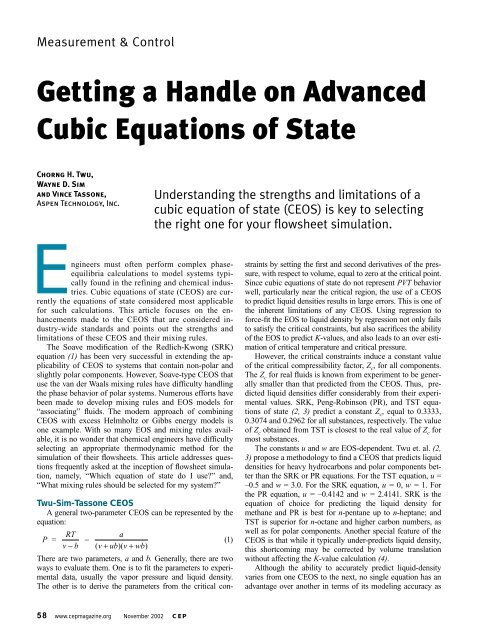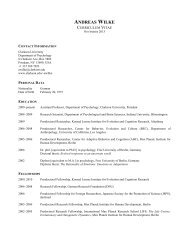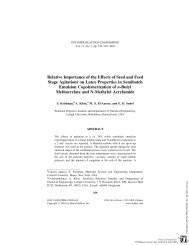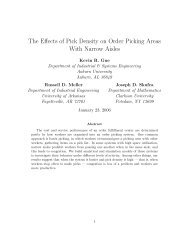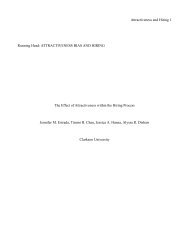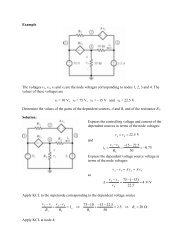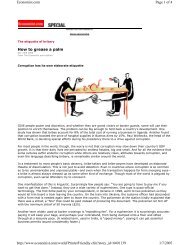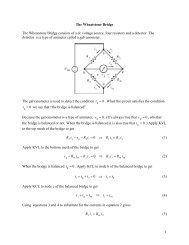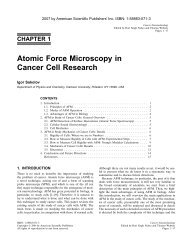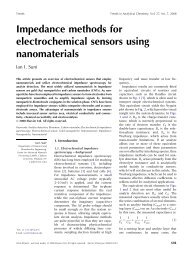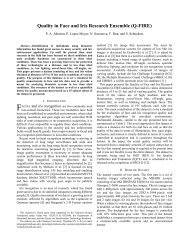Getting a Handle on Advanced Cubic Equations of State
Getting a Handle on Advanced Cubic Equations of State
Getting a Handle on Advanced Cubic Equations of State
Create successful ePaper yourself
Turn your PDF publications into a flip-book with our unique Google optimized e-Paper software.
Measurement & C<strong>on</strong>trol<br />
<str<strong>on</strong>g>Getting</str<strong>on</strong>g> a <str<strong>on</strong>g>Handle</str<strong>on</strong>g> <strong>on</strong> <strong>Advanced</strong><br />
<strong>Cubic</strong> Equati<strong>on</strong>s <strong>of</strong> <strong>State</strong><br />
Chorng H. Twu,<br />
Wayne D. Sim<br />
and Vince Tass<strong>on</strong>e,<br />
Aspen Technology, Inc.<br />
E<br />
ngineers must <strong>of</strong>ten perform complex phaseequilibria<br />
calculati<strong>on</strong>s to model systems typically<br />
found in the refining and chemical industries.<br />
<strong>Cubic</strong> equati<strong>on</strong>s <strong>of</strong> state (CEOS) are currently<br />
the equati<strong>on</strong>s <strong>of</strong> state c<strong>on</strong>sidered most applicable<br />
for such calculati<strong>on</strong>s. This article focuses <strong>on</strong> the enhancements<br />
made to the CEOS that are c<strong>on</strong>sidered industry-wide<br />
standards and points out the strengths and<br />
limitati<strong>on</strong>s <strong>of</strong> these CEOS and their mixing rules.<br />
The Soave modificati<strong>on</strong> <strong>of</strong> the Redlich-Kw<strong>on</strong>g (SRK)<br />
equati<strong>on</strong> (1) has been very successful in extending the applicability<br />
<strong>of</strong> CEOS to systems that c<strong>on</strong>tain n<strong>on</strong>-polar and<br />
slightly polar comp<strong>on</strong>ents. However, Soave-type CEOS that<br />
use the van der Waals mixing rules have difficulty handling<br />
the phase behavior <strong>of</strong> polar systems. Numerous efforts have<br />
been made to develop mixing rules and EOS models for<br />
“associating” fluids. The modern approach <strong>of</strong> combining<br />
CEOS with excess Helmholtz or Gibbs energy models is<br />
<strong>on</strong>e example. With so many EOS and mixing rules available,<br />
it is no w<strong>on</strong>der that chemical engineers have difficulty<br />
selecting an appropriate thermodynamic method for the<br />
simulati<strong>on</strong> <strong>of</strong> their flowsheets. This article addresses questi<strong>on</strong>s<br />
frequently asked at the incepti<strong>on</strong> <strong>of</strong> flowsheet simulati<strong>on</strong>,<br />
namely, “Which equati<strong>on</strong> <strong>of</strong> state do I use?” and,<br />
“What mixing rules should be selected for my system?”<br />
Twu-Sim-Tass<strong>on</strong>e CEOS<br />
A general two-parameter CEOS can be represented by the<br />
equati<strong>on</strong>:<br />
P<br />
=<br />
RT<br />
v−b −<br />
a<br />
( v+ ub) ( v+ wb)<br />
There are two parameters, a and b. Generally, there are two<br />
ways to evaluate them. One is to fit the parameters to experimental<br />
data, usually the vapor pressure and liquid density.<br />
The other is to derive the parameters from the critical c<strong>on</strong>-<br />
58 www.cepmagazine.org November 2002 CEP<br />
Understanding the strengths and limitati<strong>on</strong>s <strong>of</strong> a<br />
cubic equati<strong>on</strong> <strong>of</strong> state (CEOS) is key to selecting<br />
the right <strong>on</strong>e for your flowsheet simulati<strong>on</strong>.<br />
() 1<br />
straints by setting the first and sec<strong>on</strong>d derivatives <strong>of</strong> the pressure,<br />
with respect to volume, equal to zero at the critical point.<br />
Since cubic equati<strong>on</strong>s <strong>of</strong> state do not represent PVT behavior<br />
well, particularly near the critical regi<strong>on</strong>, the use <strong>of</strong> a CEOS<br />
to predict liquid densities results in large errors. This is <strong>on</strong>e <strong>of</strong><br />
the inherent limitati<strong>on</strong>s <strong>of</strong> any CEOS. Using regressi<strong>on</strong> to<br />
force-fit the EOS to liquid density by regressi<strong>on</strong> not <strong>on</strong>ly fails<br />
to satisfy the critical c<strong>on</strong>straints, but also sacrifices the ability<br />
<strong>of</strong> the EOS to predict K-values, and also leads to an over estimati<strong>on</strong><br />
<strong>of</strong> critical temperature and critical pressure.<br />
However, the critical c<strong>on</strong>straints induce a c<strong>on</strong>stant value<br />
<strong>of</strong> the critical compressibility factor, Z c , for all comp<strong>on</strong>ents.<br />
The Z c for real fluids is known from experiment to be generally<br />
smaller than that predicted from the CEOS. Thus, predicted<br />
liquid densities differ c<strong>on</strong>siderably from their experimental<br />
values. SRK, Peng-Robins<strong>on</strong> (PR), and TST equati<strong>on</strong>s<br />
<strong>of</strong> state (2, 3) predict a c<strong>on</strong>stant Z c , equal to 0.3333,<br />
0.3074 and 0.2962 for all substances, respectively. The value<br />
<strong>of</strong> Z c obtained from TST is closest to the real value <strong>of</strong> Z c for<br />
most substances.<br />
The c<strong>on</strong>stants u and w are EOS-dependent. Twu et. al. (2,<br />
3) propose a methodology to find a CEOS that predicts liquid<br />
densities for heavy hydrocarb<strong>on</strong>s and polar comp<strong>on</strong>ents better<br />
than the SRK or PR equati<strong>on</strong>s. For the TST equati<strong>on</strong>, u =<br />
–0.5 and w = 3.0. For the SRK equati<strong>on</strong>, u = 0, w = 1. For<br />
the PR equati<strong>on</strong>, u = –0.4142 and w = 2.4141. SRK is the<br />
equati<strong>on</strong> <strong>of</strong> choice for predicting the liquid density for<br />
methane and PR is best for n-pentane up to n-heptane; and<br />
TST is superior for n-octane and higher carb<strong>on</strong> numbers, as<br />
well as for polar comp<strong>on</strong>ents. Another special feature <strong>of</strong> the<br />
CEOS is that while it typically under-predicts liquid density,<br />
this shortcoming may be corrected by volume translati<strong>on</strong><br />
without affecting the K-value calculati<strong>on</strong> (4).<br />
Although the ability to accurately predict liquid-density<br />
varies from <strong>on</strong>e CEOS to the next, no single equati<strong>on</strong> has an<br />
advantage over another in terms <strong>of</strong> its modeling accuracy as
l<strong>on</strong>g as the same alpha functi<strong>on</strong> (for pure-comp<strong>on</strong>ent vapor<br />
pressure correlati<strong>on</strong>) and the same mixing rules (for mixtureproperty<br />
correlati<strong>on</strong>) are used (5). Since the ability <strong>of</strong> any<br />
CEOS to predict phase equilibria <strong>of</strong> mixtures depends <strong>on</strong> the<br />
alpha functi<strong>on</strong> and the mixing rule, these two elements will be<br />
the focus <strong>of</strong> the remainder <strong>of</strong> this article.<br />
Alpha functi<strong>on</strong>s for cubic equati<strong>on</strong>s <strong>of</strong> state<br />
The accurate predicti<strong>on</strong> <strong>of</strong> K-values from any CEOS requires<br />
an equally accurate predicti<strong>on</strong> <strong>of</strong> pure-comp<strong>on</strong>ent<br />
vapor pressures, which depends <strong>on</strong> the development <strong>of</strong> an appropriate<br />
alpha functi<strong>on</strong> α(T). The first CEOS to be successfully<br />
applied to the calculati<strong>on</strong> <strong>of</strong> thermodynamic properties<br />
for the vapor phase was the modified form <strong>of</strong> the van der<br />
Waals equati<strong>on</strong> by Redlich and Kw<strong>on</strong>g (6), who incorporated<br />
temperature dependence into the a term:<br />
P<br />
=<br />
RT<br />
v−b The success <strong>of</strong> the Redlich-Kw<strong>on</strong>g (RK) equati<strong>on</strong> stimulated<br />
numerous researchers to propose various correlati<strong>on</strong>s for improving<br />
the predicti<strong>on</strong> <strong>of</strong> vapor pressure. Wils<strong>on</strong> (7) first introduced<br />
a general form <strong>of</strong> temperature dependence <strong>of</strong> the a<br />
parameter in the RK equati<strong>on</strong> in 1964:<br />
a(T) = α(T)a c<br />
−<br />
05 .<br />
aT<br />
vv ( + b)<br />
where a c is the value <strong>of</strong> a at the critical point. In 1966, Wils<strong>on</strong><br />
(8) expressed α(T) as a functi<strong>on</strong> <strong>of</strong> the reduced temperature,<br />
T r = T/T c , and the acentric factor ω as follows:<br />
α(T) = T r + (1.57 + 1.62ω)(1 – T r ) (4)<br />
However, since the error <strong>of</strong> predicted vapor pressure from Eq.<br />
4 is quite large, Wils<strong>on</strong>’s functi<strong>on</strong> did not find widespread<br />
use. The α(T) functi<strong>on</strong> that did find its way into the mainstream<br />
was proposed by Soave in 1972. He developed a linear<br />
equati<strong>on</strong> for α as a functi<strong>on</strong> <strong>of</strong> temperature by plotting α 0.5<br />
against T r 0.5 at a c<strong>on</strong>stant ω:<br />
α(T) = (1 + m(1 – T r 0.5)) 2 (5)<br />
The m parameter is obtained by forcing the equati<strong>on</strong> to reproduce<br />
vapor pressures for light hydrocarb<strong>on</strong>s corresp<strong>on</strong>ding to<br />
C 1 through C 10 at T r = 0.7, and is correlated as a functi<strong>on</strong> <strong>of</strong> ω:<br />
m = 0.480 + 1.57ω – 0.176ω 2 (6)<br />
( 2)<br />
Soave’s development <strong>of</strong> Eqs. 5 and 6 represented a great step<br />
forward in the practical applicati<strong>on</strong> <strong>of</strong> CEOS. The Soave α(T),<br />
(or Eq. 5) defined as a functi<strong>on</strong> <strong>of</strong> both T r and ω, is good for<br />
predicting the vapor pressures <strong>of</strong> hydrocarb<strong>on</strong>s at temperatures<br />
above their normal boiling points, but not at c<strong>on</strong>diti<strong>on</strong>s above<br />
the critical point, since the functi<strong>on</strong> does not decrease m<strong>on</strong>o-<br />
(3)<br />
Nomenclature<br />
a, b = CEOS parameters<br />
a * , b * = reduced parameters <strong>of</strong> a and b<br />
A =Helmholtz energy<br />
c1 ,c2 ,c3 = c<strong>on</strong>stants in α(T) functi<strong>on</strong> (Eq. 14, 15)<br />
C1 = c<strong>on</strong>stant at infinite pressure<br />
Cr = c<strong>on</strong>stant at zero pressure<br />
Cv0 = functi<strong>on</strong> at zero pressure<br />
G = Gibbs energy<br />
k<br />
ij , k ij<br />
= binary interacti<strong>on</strong> parameter<br />
= binary interacti<strong>on</strong> parameter<br />
l ij<br />
m = parameter in Soave’s equati<strong>on</strong> for α(T), Eq. 5<br />
n = parameter in Soave’s expanded equati<strong>on</strong> for α(T), Eq. 7<br />
L, M, N = parameters in the Twu α functi<strong>on</strong><br />
P = pressure<br />
R = ideal gas c<strong>on</strong>stant<br />
r = c<strong>on</strong>stant reduced liquid volume at zero-pressure<br />
T = temperature<br />
u, w = CEOS c<strong>on</strong>stants<br />
v = molar volume<br />
v 0 * = reduced liquid volume at zero pressure<br />
V = total volume<br />
x = mole fracti<strong>on</strong> <strong>of</strong> comp<strong>on</strong>ent i in liquid phase<br />
i<br />
Z = compressibility facto<br />
Greek letters<br />
α = CEOS alpha functi<strong>on</strong><br />
δ = parameter used to define τ<br />
ω = acentric factor<br />
τ = parameter used in TST excess Gibbs energy model<br />
Subscripts<br />
0 = zero pressure<br />
∞ = infinite pressure<br />
c = critical property<br />
i, j ,k = property <strong>of</strong> comp<strong>on</strong>ent i, j, k<br />
ij, ji = interacti<strong>on</strong> property between comp<strong>on</strong>ents i and j<br />
ik, ki = interacti<strong>on</strong> property between comp<strong>on</strong>ents i and k<br />
r = reduced property<br />
vdw = van der Waals<br />
Superscripts<br />
* = reduced property<br />
E = excess property<br />
(0) and (1) = denotes value <strong>of</strong> α when ω = 0 and ω = 1<br />
† Any c<strong>on</strong>sistent set <strong>of</strong> units is acceptable.<br />
t<strong>on</strong>ically with increasing temperature.<br />
Another shortcoming <strong>of</strong> Soave’s α(T) functi<strong>on</strong> is that the<br />
calculated vapor pressures tend to diverge from the experimental<br />
<strong>on</strong>es at low temperatures. Therefore, Soave proposed a<br />
new α(T) functi<strong>on</strong> to improve vapor-pressure predicti<strong>on</strong> by<br />
expanding Eq. 5 as follows (9):<br />
α(T) = 1 + m(1 – T r )+n(1 – T r 0.5) 2 (7)<br />
where m and n are obtained by correlating vapor-pressure values<br />
generated by the Lee-Kesler EOS:<br />
m = 0.484 + 1.515ω – 0.44ω 2 (8)<br />
n = 2.756m – 0.700 (9)<br />
CEP November 2002 www.cepmagazine.org 59
Measurement & C<strong>on</strong>trol<br />
Unfortunately, the accuracy <strong>of</strong> predicting<br />
vapor pressure from Soave’s new α(T)<br />
was no better than the original <strong>on</strong>e, and<br />
c<strong>on</strong>sequently, was never accepted for applicati<strong>on</strong>.<br />
Numerous investigators have<br />
tried to improve Soave’s alpha functi<strong>on</strong><br />
by either altering the parameters or<br />
adding extra terms. But as l<strong>on</strong>g as the<br />
same or a similar form <strong>of</strong> the alpha functi<strong>on</strong><br />
is used, and the same approach as<br />
Soave is applied (i.e., plotting α 0.5 vs.<br />
T r 0.5), the functi<strong>on</strong>’s inherent weaknesswill<br />
not be overcome.<br />
Better vapor pressure predicti<strong>on</strong><br />
Twu et. al. (10, 11) developed a new<br />
methodology to improve the accuracy <strong>of</strong> the<br />
vapor-pressure predicti<strong>on</strong> from a CEOS.<br />
They found that the alpha functi<strong>on</strong> is a linear<br />
functi<strong>on</strong> <strong>of</strong> the acentric factor at a c<strong>on</strong>stant<br />
reduced temperature.<br />
α = α (0) + ω(α (1) – α (0) ) (10)<br />
α ( ) ( ) 0 N M − 1 L ( 1−<br />
T )<br />
=<br />
e r<br />
T r<br />
( 1) ( 1)<br />
N M<br />
α () ( ) ( 1) ( 1) ( 1)<br />
1 N M − 1 L ( 1−<br />
T )<br />
=<br />
e r<br />
T r<br />
( 0) ( 0) ( 0 )<br />
( 0 ) ( 0 )<br />
N M<br />
( 11)<br />
( 12)<br />
The superscripts (0) and (1) in Eqs. 10, 11 and 12 are c<strong>on</strong>sistent<br />
with the definiti<strong>on</strong> <strong>of</strong> the acentric factor at ω = 0 and ω<br />
=1, respectively. In other words, these two alpha functi<strong>on</strong>s are<br />
forced to pass through the saturated vapor pressure at T r = 0.7<br />
for ω = 0 and ω = 1, respectively.<br />
Twu et. al. used the latest data from the DIPPR (12) databank<br />
to generate the values <strong>of</strong> α (0) and α (1) for SRK, PR and<br />
TST cubic equati<strong>on</strong>s <strong>of</strong> state. Tables 1–3 show the L, M, and N<br />
values used with Eqs. 11 and 12 for SRK, PR and TST CEOS,<br />
respectively. The advantage <strong>of</strong> having a linear acentric factor is<br />
that <strong>on</strong>e can reliably extrapolate its value for heavy hydrocarb<strong>on</strong>s.<br />
The new generalized α(T) functi<strong>on</strong> for SRK, PR and<br />
TST, in Eqs. 10–12, allows the accurate predicti<strong>on</strong> <strong>of</strong> vaporpressure<br />
data from the triple point to the critical point for light<br />
or heavy hydrocarb<strong>on</strong>s using any <strong>of</strong> these EOS.<br />
Although the Twu alpha functi<strong>on</strong> menti<strong>on</strong>ed above works<br />
very well for n<strong>on</strong>-polar comp<strong>on</strong>ents, it is generally not suitable<br />
for polar comp<strong>on</strong>ents. In an attenpt to resolve this difficulty,<br />
Soave (13) presents a two-parameter alpha functi<strong>on</strong>:<br />
α(T) = 1 + (1 – T r )(m + n/T r ) (13)<br />
where m and n are empirical c<strong>on</strong>stants that are fitted to the<br />
vapor pressure <strong>of</strong> the comp<strong>on</strong>ent <strong>of</strong> interest, and are not related<br />
to previously menti<strong>on</strong>ed m and n c<strong>on</strong>stants. Eq. 13 fits<br />
vapor pressure quite well, but the functi<strong>on</strong> can become nega-<br />
60 www.cepmagazine.org November 2002 CEP<br />
Table 1.<br />
Tr ≤ 1 Tr > 1<br />
α Parameter α (0) α (1) α (0) α (1)<br />
L 0.544000 0.544306 0.379919 0.0319134<br />
M 1.01309 0.802404 5.67342 1.28756<br />
N 0.935995 3.10835 –0.200000 –8.000000<br />
The L, M and N databank <strong>of</strong> the generalized alpha functi<strong>on</strong> for Eqs. 11 and 12 with the<br />
Soave-Redlich-Kw<strong>on</strong>g EOS for subcritical and supercritical c<strong>on</strong>diti<strong>on</strong>s.<br />
Table 2.<br />
Tr ≤ 1 Tr > 1<br />
α Parameter α (0) α (1) α (0) α (1)<br />
L 0.272838 0.625701 0.373949 0.0239035<br />
M 0.924779 0.792014 4.73020 1.24615<br />
N 1.19764 2.46022 –0.200000 –8.000000<br />
The L, M and N databank <strong>of</strong> the generalized alpha functi<strong>on</strong> for Eqs. 11 and 12 with the<br />
Peng-Robins<strong>on</strong> EOS for subcritical and supercritical c<strong>on</strong>diti<strong>on</strong>s.<br />
Table 3.<br />
Tr ≤ 1 Tr > 1<br />
α Parameter α (0) α (1) α (0) α (1)<br />
L 0.196545 0.704001 0.358826 0.0206444<br />
M 0.906437 0.790407 4.23478 1.22942<br />
N 1.26251 2.13086 –0.200000 –8.000000<br />
The L, M and N databank <strong>of</strong> the generalized alpha functi<strong>on</strong> for Eqs. 11 and 12 with the<br />
Twu-Sim-Tass<strong>on</strong>e EOS for subcritical and supercritical c<strong>on</strong>diti<strong>on</strong>s.<br />
tive at high temperatures. Since the alpha functi<strong>on</strong> represents<br />
the attractive forces, it is physically incorrect for it to be negative.<br />
Mathias (14) and Mathias and Copeman (15) proposed<br />
α(T) functi<strong>on</strong>s similar to Soave’s (Eq. 5). Mathias’ α(T) functi<strong>on</strong><br />
is expressed as:<br />
α(T) = (1 + c 1 (1 – T r 0.5) + c 2 (1 – T r ) (0.7 – T r 0.5)) 2 (14)<br />
while Mathias and Copeman’s α(Τ) functi<strong>on</strong> takes the form:<br />
α(T) = (1 + c 1 (1 – T r 0.5) + c 2 (1 – T r 0.5) 2 + c 3 (1 – T r 0.5) 3 ) 2 (15)<br />
Both functi<strong>on</strong>s increase with increasing temperature at the supercritical<br />
regi<strong>on</strong>. To overcome this difficulty, a sec<strong>on</strong>d correlati<strong>on</strong><br />
for the α(T) functi<strong>on</strong> at temperatures higher than the T c<br />
is <strong>of</strong>ten required. However, using a sec<strong>on</strong>d correlati<strong>on</strong> creates<br />
a disc<strong>on</strong>tinuity in these alpha functi<strong>on</strong>s at the critical point<br />
and produces deviati<strong>on</strong>s in the predicted enthalpies.<br />
Melhem et. al. (16) proposed a similar, but logarithmic<br />
form <strong>of</strong> α(T):<br />
α(T) = exp[1 + c 1 (1 – T r 0.5) + c 2 (1 – T r 0.5)] 2 (16)<br />
The accuracy <strong>of</strong> vapor pressure regressed from this model is<br />
not as good as that for the other functi<strong>on</strong>s menti<strong>on</strong>ed above.<br />
Twu (17) derived α(T) from a probability distributi<strong>on</strong>:<br />
NM<br />
N( M − 1) L ( 1−<br />
T ) r<br />
r<br />
α ( T) = T e<br />
( 17)<br />
Eq. 17 has three parameters, L, M and N, which, unlike those<br />
in Tables 1–3, are unique for each comp<strong>on</strong>ent and are determined<br />
from the regressi<strong>on</strong> <strong>of</strong> pure-comp<strong>on</strong>ent vapor-pressure<br />
data. The authors have set up databanks for L, M and N for a
wide range <strong>of</strong> comp<strong>on</strong>ents, which can be obtained by c<strong>on</strong>tacting<br />
the authors directly. Twu’s α(T) functi<strong>on</strong> has been found<br />
to be more accurate than other α(T) functi<strong>on</strong>s found in literature<br />
for predicting vapor pressures for polar and n<strong>on</strong>-polar<br />
comp<strong>on</strong>ents at temperatures ranging from the triple point to<br />
the critical point. Using the comp<strong>on</strong>ent-dependent parameters,<br />
the accuracy <strong>of</strong> reproducing the vapor pressure from Eq.<br />
17 is within experimental error given in DIPPR.<br />
Twu’s α(T) functi<strong>on</strong> has some unique features. Fluids such<br />
as hydrogen exhibit a maximum alpha at low temperatures<br />
(about 19 K). Twu’s α(T) functi<strong>on</strong> accurately describes this<br />
behavior and is the <strong>on</strong>ly functi<strong>on</strong> so far that shows this maximum<br />
at low temperature. In additi<strong>on</strong>, it is c<strong>on</strong>tinuous at the<br />
critical point for all comp<strong>on</strong>ents and extrapolates very well to<br />
supercritical c<strong>on</strong>diti<strong>on</strong>s without exhibiting abnormal characteristics,<br />
such as increasing with increasing temperature.<br />
Due to the accuracy and wide temperature range <strong>of</strong> applicati<strong>on</strong><br />
<strong>of</strong> the advanced Twu α(T) functi<strong>on</strong>s (Eqs. 10, 11, 12 and<br />
17) for predicting vapor pressures when used in the SRK, PR<br />
and TST equati<strong>on</strong>s <strong>of</strong> state, these equati<strong>on</strong>s have been selected<br />
for use in the SRK, PR and TST models as follows. For<br />
petroleum fracti<strong>on</strong>s and comp<strong>on</strong>ents that do not have vaporpressure<br />
data available, Eqs. 10, 11 and 12 should be used. For<br />
all comp<strong>on</strong>ents that do have vapor-pressure data available, Eq.<br />
17 can be used.<br />
van der Waals mixing rules<br />
In additi<strong>on</strong> to using an appropriate α(T) functi<strong>on</strong> for the<br />
accurate predicti<strong>on</strong> <strong>of</strong> vapor pressure, the ability <strong>of</strong> a CEOS to<br />
correlate and predict phase equilibria <strong>of</strong> mixtures depends<br />
str<strong>on</strong>gly up<strong>on</strong> the mixing rule applied. The most comm<strong>on</strong>ly<br />
used method to extend equati<strong>on</strong>s <strong>of</strong> state to a n<strong>on</strong>-polar mixture<br />
is to use the van der Waals <strong>on</strong>e-fluid mixing rules:<br />
a = ∑ ∑ x x a a 1−k i<br />
where kij is the binary interacti<strong>on</strong> parameter that is obtained<br />
from the regressi<strong>on</strong> <strong>of</strong> vapor-liquid equilibrium data. The van<br />
der Waals mixing rules are capable <strong>of</strong> accurately representing<br />
vapor-liquid equilibria using <strong>on</strong>ly <strong>on</strong>e binary-interacti<strong>on</strong> parameter<br />
for n<strong>on</strong>-polar or slightly polar systems. However,<br />
many mixtures <strong>of</strong> interest in the chemical industry c<strong>on</strong>tain<br />
str<strong>on</strong>gly polar or associating comp<strong>on</strong>ents. One way to modify<br />
the van der Waals mixing rules so that they can better describe<br />
polar systems is to use the asymmetric kij for the a parameter,<br />
as developed by Twu et. al. (17):<br />
a = ∑ ∑ xixj aa i j ( 1−kij)+ i<br />
j<br />
b = x x<br />
⎡1<br />
∑ ∑ i j b + b<br />
i j ⎣⎢ 2<br />
j<br />
i j<br />
( )<br />
i j ij<br />
( i j)<br />
⎤<br />
⎦⎥<br />
( ) ( − )<br />
⎡<br />
∑ x ⎢∑<br />
x aa k k<br />
i ⎣ j<br />
i j i j ji ij<br />
⎤<br />
⎥<br />
⎦<br />
16 13 3<br />
/<br />
( 18)<br />
( 19)<br />
( 20)<br />
Eq. 20 has two adjustable parameters, k ij and k ji . Generally,<br />
they are not equal. The use <strong>of</strong> an asymmetric definiti<strong>on</strong> <strong>of</strong> k ij<br />
in the van der Waals mixing rule <strong>of</strong> Eq. 20 is similar to the<br />
asymmetric parameters A ij and A ij used in the excess Gibbs<br />
energy (G E ) mixing rule <strong>of</strong> the NRTL model. If k ij = k ij , Eq. 20<br />
reduces to the van der Waals mixing rule (Eq. 18).<br />
The modified van der Waals mixing rule (Eq. 20) provides<br />
accurate correlati<strong>on</strong> <strong>of</strong> complex mixtures, including highly<br />
n<strong>on</strong>-ideal systems that previously could <strong>on</strong>ly be correlated by<br />
activity-coefficient models. However, Eq. 20 no l<strong>on</strong>ger satisfies<br />
the sec<strong>on</strong>d virial coefficient.<br />
Hur<strong>on</strong>-Vidal infinite-pressure mixing rules<br />
Since the van der Waals mixing rules are applicable <strong>on</strong>ly<br />
to mixtures whose excess Gibbs energy can be approximated<br />
by the regular soluti<strong>on</strong> theory, quite a few new mixing rules<br />
have been recently developed based <strong>on</strong> appropriate excess<br />
energy models. Hur<strong>on</strong> and Vidal (18) successfully formulated<br />
a new EOS parameter a by assuming that the excess<br />
Gibbs energy at infinite pressure, GE ∞ , which is derived from<br />
a CEOS, is equal to GE derived from a liquid-activity-coefficient<br />
model. They also assumed that the liquid volume at infinite<br />
pressure equals the EOS co-volume, b. The Hur<strong>on</strong>-<br />
Vidal derivati<strong>on</strong> led to the following equati<strong>on</strong> for a * :<br />
The parameters a * and b * a b x<br />
in Eq. 21 are defined as:<br />
a<br />
* * ⎡ *<br />
i<br />
= ⎢∑<br />
i *<br />
⎣ i bi 1 G<br />
+<br />
⎛ ∞ ⎞ ⎤<br />
C ⎝ RT ⎠ ⎥<br />
1 ⎦<br />
( 21)<br />
a * = Pa/R 2 T 2 and b * = Pb/RT (21a, b)<br />
The Hur<strong>on</strong>-Vidal approach uses the c<strong>on</strong>venti<strong>on</strong>al linear<br />
mixing rule for the b parameter:<br />
b = xx<br />
⎡1<br />
∑ ∑ i j b i + b<br />
⎤<br />
( j)<br />
i j ⎣⎢ 2 ⎦⎥<br />
The C1 in Eq. 21 is a c<strong>on</strong>stant, and is defined as:<br />
E<br />
( 22)<br />
1 w<br />
C =−<br />
⎛1+<br />
⎞<br />
1<br />
ln<br />
( 23)<br />
( w−u) ⎝ 1 + u ⎠<br />
where u and w are EOS-dependent c<strong>on</strong>stants used to represent<br />
a particular two-parameter CEOS. For example, u = –0.5 and<br />
w = 3.0 for the TST CEOS.<br />
Although Hur<strong>on</strong> and Vidal presented their model more than<br />
two decades ago, their mixing rule is not widely used due to lack<br />
<strong>of</strong> parameters available in literature for the excess Gibbs energy<br />
at infinite pressure and the inability to accurately describe n<strong>on</strong>polar<br />
hydrocarb<strong>on</strong> mixtures and to satisfy the quadratic compositi<strong>on</strong><br />
dependence <strong>of</strong> the sec<strong>on</strong>d virial coefficient.<br />
W<strong>on</strong>g-Sandler infinite-pressure mixing rules<br />
The Hur<strong>on</strong>-Vidal approach requires the excess volume, V E ,<br />
to be zero and EOS parameter b to be calculated via a linear<br />
mixing rule. To allow the use <strong>of</strong> a different mixing rule for parameter<br />
b, W<strong>on</strong>g and Sandler (19) developed a model equating<br />
CEP November 2002 www.cepmagazine.org 61
Measurement & C<strong>on</strong>trol<br />
the excess Helmholtz energy at infinite pressure from a CEOS<br />
to excess Helmholtz energy calculated from an activity coefficient<br />
model, and they c<strong>on</strong>strained the EOS parameters a and b<br />
to satisfy the sec<strong>on</strong>d-virial-coefficient c<strong>on</strong>diti<strong>on</strong>:<br />
a b x a<br />
E<br />
* * ⎡ *<br />
i 1 A<br />
= ∑ i * +<br />
⎛ ∞ ⎞ ⎤<br />
⎢<br />
( )<br />
⎣ i biC ⎝ RT ⎠ ⎥<br />
24<br />
1 ⎦<br />
n n a<br />
xx<br />
⎛ ij<br />
∑ ∑ i j bij<br />
−<br />
⎞<br />
j ⎝ RT ⎠<br />
i b =<br />
a*<br />
1 − *<br />
b<br />
The W<strong>on</strong>g-Sandler model introduced a binary interacti<strong>on</strong> parameter,<br />
k<br />
ij , to correct the assumpti<strong>on</strong> that the excess<br />
Helmholtz free energy at infinite pressure can be approximated<br />
by the excess Gibbs free energy at low pressure:<br />
b<br />
ij<br />
a<br />
a a<br />
ij 1 ⎡<br />
i<br />
j<br />
− =<br />
⎛<br />
bi<br />
−<br />
⎞ ⎛ ⎞ ⎤<br />
⎢ + bj<br />
− 1 k<br />
RT ⎝ RT ⎠<br />
⎜ ⎟<br />
⎣<br />
⎝ RT ⎠<br />
⎥ −<br />
2<br />
⎦<br />
W<strong>on</strong>g and Sandler dem<strong>on</strong>strated that parameters in the activity<br />
coefficient models correlated at low temperatures can be<br />
used to extrapolate to higher temperatures. Michelsen and<br />
Heidemann (20) suggest that this success is fortuitous.<br />
In an effort to reduce the W<strong>on</strong>g-Sandler mixing rules to the<br />
c<strong>on</strong>venti<strong>on</strong>al van der Waals mixing rules, Orbey and Sandler<br />
(21) modify the G E model <strong>of</strong> NRTL differently. C<strong>on</strong>sequently,<br />
the mixing rules used in their model cannot employ the NRTL<br />
parameters reported in the DECHEMA Chemistry Data<br />
Series.<br />
Twu-Co<strong>on</strong> infinite-pressure mixing rules<br />
Twu and Co<strong>on</strong> (22) used a van der Waals mixture as a reference<br />
to derive the mixing rules for their EOS. These mixing<br />
rules re-define a and b as:<br />
*<br />
E E<br />
* * ⎡avdw<br />
1 A A vdw<br />
a = b * +<br />
⎛ ∞ ∞<br />
−<br />
⎞ ⎤<br />
⎢<br />
( )<br />
b C ⎝ RT RT ⎠ ⎥<br />
27<br />
⎣ vdw 1<br />
⎦<br />
* *<br />
*<br />
bvdw − avdw<br />
b =<br />
( 28)<br />
*<br />
E E<br />
⎡avdw<br />
1 A A vdw<br />
− * +<br />
⎛ ∞ ∞<br />
−<br />
⎞ ⎤<br />
1 ⎢<br />
⎣ bvdw C ⎝ RT RT ⎠ ⎥<br />
1<br />
⎦<br />
C1 in Eqs. 27 and 28 is defined in Eq. 23. The asymmetric van<br />
der Waals mixing rule is applied to the avdw parameter, and the<br />
linear mixing rule is used for the bvdw parameter:<br />
avdw = ∑ ∑ xixj aa i j ( 1−kij)+ i<br />
j<br />
( ) ( − )<br />
⎡<br />
∑ x ⎢∑<br />
x aa k k<br />
i ⎣ j<br />
i j i j ji ij<br />
( j )<br />
bvdw = x x<br />
⎡1<br />
∑ ∑ i j b + b<br />
i j ⎣⎢ 2<br />
⎤<br />
⎦⎥<br />
⎤<br />
⎥<br />
⎦<br />
16 13 3<br />
/ /<br />
( ij )<br />
( 25)<br />
( 26)<br />
( 29)<br />
( 30)<br />
Subscript vdw in AE in Eqs. 27 and 28 denotes that the proper-<br />
∞ vdw<br />
ties are evaluated from the CEOS using the van der Waals mixing<br />
62 www.cepmagazine.org November 2002 CEP<br />
rule for its a and b parameters as given by Eqs. 29 and 30.<br />
The Twu-Co<strong>on</strong> mixing rules reduce to the van der Waals<br />
mixing rules if AE ∞ = AE . It is extremely desirable that the<br />
∞ vdw<br />
compositi<strong>on</strong>-dependent mixing rules reduce to the classical<br />
mixing rules because the latter work very well for n<strong>on</strong>-polar<br />
systems. The use <strong>of</strong> asymmetric parameters, k and k ,im-<br />
ij ij<br />
proves the accuracy <strong>of</strong> the reproducti<strong>on</strong> <strong>of</strong> the liquid-activity<br />
coefficients. Although it may be more accurate to simply refit<br />
the GE parameters in the mixing rules instead <strong>of</strong> introducing<br />
two new parameters, k and k , to match the results <strong>of</strong> the ac-<br />
ij ij<br />
tivity coefficient model, doing so would sacrifice the extrapolati<strong>on</strong><br />
ability <strong>of</strong> the infinite-pressure approach. Furthermore,<br />
the original idea <strong>of</strong> using directly published parameters for activity<br />
coefficient models in the equati<strong>on</strong> <strong>of</strong> state will be lost.<br />
Twu-Sim-Tass<strong>on</strong>e infinite-pressure mixing rules<br />
It is a challenge to find a general expressi<strong>on</strong> for AE ∞ that<br />
can be simplified to AE in the Twu-Co<strong>on</strong> infinite-pressure<br />
∞ vdw<br />
mixing rules (Eqs. 27 and 28). As menti<strong>on</strong>ed previously,<br />
Orbey and Sandler modified the GE model <strong>of</strong> NRTL to a different<br />
form to reduce the W<strong>on</strong>g-Sandler mixing rules to the<br />
c<strong>on</strong>venti<strong>on</strong>al van der Waals mixing rules. Twu et. al. (23) developed<br />
a new excess Gibbs energy functi<strong>on</strong>, which reduces<br />
to the van der Waals <strong>on</strong>e-fluid mixing rule (Eqs. 18 and 19).<br />
The incorporati<strong>on</strong> <strong>of</strong> this new excess Gibbs functi<strong>on</strong> into a<br />
CEOS allows the Twu-Co<strong>on</strong> infinite-pressure mixing rules to<br />
smoothly transiti<strong>on</strong> to the c<strong>on</strong>venti<strong>on</strong>al van der Waals <strong>on</strong>efluid<br />
mixing rules. A general multi-comp<strong>on</strong>ent equati<strong>on</strong> for a<br />
liquid activity coefficient model is proposed by Twu et. al.<br />
(23) for incorporati<strong>on</strong> in the infinite-pressure mixing rules:<br />
E ∑ x τ G<br />
G n<br />
j<br />
= ∑ xi<br />
n<br />
RT i<br />
∑ xG<br />
n<br />
k<br />
j ji ji<br />
k ki<br />
( 31)<br />
Eq. 31 appears to be similar to the NRTL equati<strong>on</strong>, but there<br />
is a fundamental difference between them. NRTL assumes A ij ,<br />
A ij , and α ij are the parameters <strong>of</strong> the model, but the TST excess<br />
Gibbs energy model assumes τ ij and G ij are the binary-interacti<strong>on</strong><br />
parameters. More importantly, any appropriate temperature-dependent<br />
functi<strong>on</strong> can be applied to τ ij and G ij . For<br />
example, to obtain the NRTL model, τ ij and G ij are calculated<br />
as usual from the NRTL parameters A ij , A ij and α ij :<br />
τ ij = A ij /T (32)<br />
G ij = exp[–α ij τ ij ] (33)<br />
In this way, the NRTL parameters reported in the DECHEMA<br />
Chemistry Data Series can be used in Eqs. 32 and 33, and both<br />
the NRTL model and the TST model (Eq. 31) are equally accurate<br />
for use in phase equilibrium calculati<strong>on</strong>s.<br />
Eq. 31 reduces to the c<strong>on</strong>venti<strong>on</strong>al van der Waals mixing<br />
rules when the following expressi<strong>on</strong>s are used for τ ij and G ij :
τ ij = (δ ij b i )/2 (34)<br />
Gji = bj /bi where:<br />
(35)<br />
⎡<br />
2<br />
C ⎛ a a ⎞<br />
i j a a<br />
⎤<br />
1<br />
i j<br />
δij =− ⎢<br />
⎜ − ⎟ + 2k⎥ ij<br />
( 36)<br />
RT ⎢<br />
⎝ bi<br />
bj<br />
⎠ bi<br />
b ⎥ j<br />
⎣⎢<br />
⎦⎥<br />
Eqs. 34 and 35 are expressed in terms <strong>of</strong> the CEOS parameters<br />
a and b and the binary interacti<strong>on</strong> parameter k . Sub-<br />
i i ij<br />
stituting Eqs. 34 and 35 into Eq. 31, the excess Gibbs free<br />
energy <strong>of</strong> the van der Waals fluid is obtained. Subsequently,<br />
Eqs. 27 and 28 reduce to the classical van der Waals<br />
<strong>on</strong>e-fluid mixing rules (Eqs. 18 and 19). The discussi<strong>on</strong><br />
above dem<strong>on</strong>strates that Eq. 31 is more generic than<br />
NRTL. Both the NRTL and van der Waals fluid models are<br />
special cases <strong>of</strong> the excess Gibbs free energy functi<strong>on</strong> expressed<br />
in Eq. 31.<br />
The TST infinite-pressure mixing rules are represented by Eqs.<br />
27–36 and can be used to model van der Waals fluids and highly<br />
n<strong>on</strong>-ideal mixtures. One can choose the appropriate expressi<strong>on</strong>s<br />
for τ and G from Eqs. 34 and 35 for binary pairs that are best de-<br />
ij ij<br />
scribed by the van der Waals <strong>on</strong>e-fluid mixing rules, while Eqs. 32<br />
and 33 can be used for pairs that behave n<strong>on</strong>-ideally.<br />
Twu(v) zero-pressure mixing rules<br />
There are generally three approaches for developing excess<br />
Helmholtz energy mixing rules for CEOS: the infinite-pressure<br />
mixing-rule approach (18, 19, 22, 29); the zero-pressure<br />
approach (3, 24–29); and the no-reference-pressure approach<br />
(30), which will not be discussed here. There is a fundamental<br />
difference behind these approaches: The infinite-pressure approach<br />
assumes the excess Helmholtz energy to be independent<br />
<strong>of</strong> pressure, whereas the zero-pressure and the no-reference-pressure<br />
approaches assume that the reduced liquid volume<br />
is either c<strong>on</strong>stant or the same as that calculated from a<br />
CEOS using the van der Waals mixing rule for its a and b parameters.<br />
As menti<strong>on</strong>ed, the infinite-pressure approach introduces<br />
binary interacti<strong>on</strong> parameters to correct the assumpti<strong>on</strong> <strong>of</strong> the<br />
c<strong>on</strong>stant excess Helmholtz energy, but it is still unable to accurately<br />
reproduce the incorporated liquid activity coefficients.<br />
To correct this shortcoming, Twu et. al. (28) developed<br />
the following zero-pressure mixing rules:<br />
a b a ⎡ *<br />
E E<br />
* * vdw 1 A A vdw<br />
= +<br />
⎛<br />
−<br />
⎞ ⎤<br />
∞ ∞<br />
⎢<br />
( )<br />
* ⎥<br />
37<br />
bvdw C ⎝<br />
v RT RT ⎠<br />
⎣⎢<br />
0<br />
⎦⎥<br />
* *<br />
*<br />
bvdw − avdw<br />
b =<br />
( )<br />
*<br />
E E<br />
avdw<br />
A A vdw bvdw<br />
− + − −ln *<br />
bvdw CvRT<br />
RT b<br />
Eqs. 37 and 38 are labeled as Twu(v) mixing rules. The parenthetic<br />
v parameter signifies that the mixing rule is volume-de-<br />
⎛<br />
38<br />
⎡ 1 ⎛<br />
⎞⎞<br />
⎤<br />
∞ ∞<br />
1 ⎢ ⎜<br />
⎝<br />
⎝ ⎠<br />
⎟ ⎥<br />
⎣⎢<br />
⎠<br />
0<br />
⎦⎥<br />
pendent. Also, the EOS a and b parameters, denoted as avdw and bvdw , are evaluated from the van der Waals mixing rules<br />
without using binary interacti<strong>on</strong> parameters:<br />
a = ∑ ∑ x x aa<br />
( 39)<br />
vdw i j<br />
i j<br />
bvdw = x x<br />
⎡1<br />
∑ ∑ i j b + b<br />
i j ⎣⎢ 2<br />
C v0 is a functi<strong>on</strong> <strong>of</strong> reduced liquid volume at zero pressure, or<br />
v 0 *=v 0 /b:<br />
C<br />
v<br />
The zero-pressure liquid volume v *<br />
0 vdw is calculated from the<br />
TST CEOS using the van der Waals mixing rule for a and b,<br />
setting pressure equal to zero and selecting the smallest root.<br />
1 ⎧ *<br />
* ⎪⎛<br />
a ⎞<br />
v0<br />
vdw = ⎨ * −u−w 2<br />
⎜ ⎟ −<br />
⎩⎪ ⎝ b ⎠<br />
u w<br />
Eq. 42 has a root as l<strong>on</strong>g as the following c<strong>on</strong>diti<strong>on</strong> is met:<br />
a<br />
uw<br />
b<br />
a<br />
⎡<br />
*<br />
2<br />
* 2<br />
⎛ ⎞ ⎛ ⎞ ⎤ ⎫<br />
⎪<br />
⎢⎜<br />
+ − * ⎟ − 4⎜+ * ⎟ ⎥ ⎬<br />
( 42)<br />
⎝ ⎠ ⎝ b ⎠<br />
⎣<br />
⎢<br />
⎦<br />
⎥<br />
⎭⎪<br />
*<br />
0<br />
i j<br />
( i j)<br />
1 ⎡v<br />
*<br />
0 +w⎤<br />
=− ln⎢<br />
⎥<br />
( w− u)<br />
⎣ v *<br />
0 + u⎦<br />
⎤<br />
⎦⎥<br />
vdw<br />
In Eqs. 37 and 38, AE 0 and AE are the excess Helmholtz<br />
0 vdw<br />
energies at zero pressure. As stated, subscript vdw in AE 0 vdw<br />
denotes that the properties are evaluated from the CEOS using<br />
the van der Waals mixing rule (Eq. 39–40) for its a and b parameters.<br />
There are numerous useful features present in the Twu(v)<br />
mixing rules, such as their ability to reduce to the van der<br />
Waals mixing rule when AE 0 = AE . The mixing rules also<br />
0 vdw<br />
satisfy the quadratic compositi<strong>on</strong> dependence <strong>of</strong> the sec<strong>on</strong>d<br />
virial coefficient boundary c<strong>on</strong>diti<strong>on</strong>. But most importantly,<br />
the Twu(v) mixing rules are density dependent in an explicit<br />
form, which allows them to reproduce, almost exactly, the<br />
incorporated GE model (Eq. 31). The mixing rules provide<br />
excellent agreement between experimental data and VLE<br />
predicti<strong>on</strong>s over a wide range <strong>of</strong> temperatures and pressures<br />
using the informati<strong>on</strong> c<strong>on</strong>tained <strong>on</strong>ly in this GE a<br />
* ≥ ( 2+ u+ w)+ 2 ( u+ 1) ( w+<br />
1) ( 43)<br />
b<br />
model.<br />
The mixing rule for parameter b defined in Eq. 38 satisfies<br />
the quadratic compositi<strong>on</strong> dependence <strong>of</strong> the sec<strong>on</strong>d<br />
virial coefficient. Alternatively, the c<strong>on</strong>venti<strong>on</strong>al linear mixing<br />
rule (Eq. 19) could be chosen to solve for b, in which<br />
case the quadratic compositi<strong>on</strong> dependence <strong>of</strong> the sec<strong>on</strong>d<br />
virial coefficient would be ignored. The mixing rule — either<br />
with or without the sec<strong>on</strong>d virial coefficient c<strong>on</strong>straint<br />
— has little effect <strong>on</strong> the phase equilibrium predicti<strong>on</strong> (28).<br />
Twu(r) zero-pressure mixing rules<br />
The Twu(v) mixing rules (Eqs. 37 and 38) are density-de-<br />
1<br />
( 40)<br />
( 41)<br />
CEP November 2002 www.cepmagazine.org 63
Measurement & C<strong>on</strong>trol<br />
pendent through the functi<strong>on</strong> C v0 . C v0 , as defined by Eq. 41, is<br />
calculated from v 0 * vdw , which is defined in Eq. 42. Solving for<br />
C v0 via Eq. 42 can cause problems when Eq. 42 has no real<br />
root. This may occur when the inequality in Eq. 43 is not satisfied.<br />
In such cases, <strong>on</strong>e must extrapolate to find v 0 *. However,<br />
by eliminating the need to calculate v 0 * from the EOS, <strong>on</strong>e<br />
can assume that the zero-pressure liquid volume <strong>of</strong> the van<br />
der Waals fluid, v 0 * vdw , is a c<strong>on</strong>stant, defined here as r:<br />
v 0 * vdw = r (44)<br />
Substituting Eq. 44 into Eq. 41 yields:<br />
1 r+w<br />
Cv<br />
=− ln<br />
⎡ ⎤<br />
0 ( w− u)<br />
⎣⎢ r+ u⎦⎥<br />
( 45)<br />
The symbol C r is used to replace C v0 to signify that C r is a<br />
Literature Cited<br />
1. Soave, G., “Equilibrium C<strong>on</strong>stants from a Modified Redlich-Kw<strong>on</strong>g<br />
Equati<strong>on</strong> <strong>of</strong> <strong>State</strong>,” Chem. Eng. Sci., 27, pp. 1197–1203 (1972).<br />
2. Twu, C. H., et. al., “An Extensi<strong>on</strong> <strong>of</strong> CEOS/A E Zero-Pressure Mixing<br />
Rule for An Optimum Two-parameter <strong>Cubic</strong> Equati<strong>on</strong> <strong>of</strong> <strong>State</strong>,” Ind.<br />
Eng. Chem. Res., 41, pp. 931–937 (2002).<br />
3. Twu, C. H., et. al., “A Versatile Liquid Activity Model for SRK, PR and<br />
A New <strong>Cubic</strong> Equati<strong>on</strong> <strong>of</strong> <strong>State</strong> TST,” Fluid Phase Equilibria, 194–197,<br />
pp. 385–399 (2002).<br />
4. Peneloux, A., et. al., “A C<strong>on</strong>sistent Correcti<strong>on</strong> for Redlich-Kw<strong>on</strong>g-Soave<br />
Volumes,” Fluid Phase Equilibria, 8, pp. 7–23 (1982).<br />
5. Twu, C. H., et. al., “Comparis<strong>on</strong> <strong>of</strong> the Peng-Robins<strong>on</strong> and Soave-<br />
Redlich-Kw<strong>on</strong>g Equati<strong>on</strong>s <strong>of</strong> <strong>State</strong> Using a New Zero-Pressure-Based<br />
Mixing Rule for the Predicti<strong>on</strong> <strong>of</strong> High Pressure and High Temperature<br />
Phase Equilibria,” Ind. Eng. Chem. Res., 37, pp. 1580–1585 (1998).<br />
6. Redlich, O., and N. S. Kw<strong>on</strong>g, “On the Thermodynamics <strong>of</strong> Soluti<strong>on</strong>s.<br />
V: An Equati<strong>on</strong> <strong>of</strong> <strong>State</strong>. Fugacities <strong>of</strong> Gaseous Soluti<strong>on</strong>s,” Chem. Rev.,<br />
44, pp. 233–244 (1949).<br />
7. Wils<strong>on</strong>, G. M., “Vapor-Liquid Equilibria Correlated by Means <strong>of</strong> a Modified<br />
Redlich-Kw<strong>on</strong>g Equati<strong>on</strong> <strong>of</strong> <strong>State</strong>,” Adv. Cryog. Eng., 9, pp.<br />
168–176 (1964).<br />
8. Wils<strong>on</strong>, G. M., “Calculati<strong>on</strong> <strong>of</strong> Enthalpy Data from a Modified Redlich-<br />
Kw<strong>on</strong>g Equati<strong>on</strong> <strong>of</strong> <strong>State</strong>,” Adv. Cryog. Eng., 11, pp. 392–400 (1966).<br />
9. Soave, G., “Improving the Treatment <strong>of</strong> Heavy Hydrocarb<strong>on</strong>s by the<br />
SRK EOS,” Fluid Phase Equilibria, 84, pp. 339–342 (1993).<br />
10. Twu, C. H., et. al., “A New Generalized Alpha Functi<strong>on</strong> for a <strong>Cubic</strong><br />
Equati<strong>on</strong> <strong>of</strong> <strong>State</strong>: Part 1. Peng-Robins<strong>on</strong> Equati<strong>on</strong>,” Fluid Phase Equilibria,<br />
105, pp. 49–59 (1995).<br />
11. Twu, C. H., et. al., “A New Generalized Alpha Functi<strong>on</strong> for a <strong>Cubic</strong><br />
Equati<strong>on</strong> <strong>of</strong> <strong>State</strong>: Part 2. Redlich-Kw<strong>on</strong>g Equati<strong>on</strong>,” Fluid Phase Equilibria,<br />
105, pp. 61–69 (1995).<br />
12.Daubert, T. E., et. al., “DIPPR Data Compilati<strong>on</strong> <strong>of</strong> Pure Compound<br />
Properties”, Project 801 Sp<strong>on</strong>sor Release, Design Institute for Physical<br />
Property Data, AIChE, New York (Jan. 2001).<br />
13. Soave, G., “Applicati<strong>on</strong> <strong>of</strong> a <strong>Cubic</strong> Equati<strong>on</strong> <strong>of</strong> <strong>State</strong> to Vapor-liquid<br />
Equilibria <strong>of</strong> Systems C<strong>on</strong>taining Polar Compounds,” Inst. Chem. Eng.<br />
Symposium Series, No. 56, 1.2/1 (1979).<br />
14. Mathias, P. M., “A Versatile Phase Equilibrium Equati<strong>on</strong> <strong>of</strong> <strong>State</strong>,” Ind.<br />
Eng. Chem., Process Des. Dev., 22, pp. 385–391 (1983).<br />
15.Mathias, P. M., and T. W. Copeman, “Extensi<strong>on</strong> <strong>of</strong> the Peng-Robins<strong>on</strong><br />
Equati<strong>on</strong> <strong>of</strong> <strong>State</strong> to Polar Fluids and Fluid Mixtures,” Fluid Phase Equilibria,<br />
13, pp. 91–108 (1983).<br />
64 www.cepmagazine.org November 2002 CEP<br />
c<strong>on</strong>stant — i.e., no l<strong>on</strong>ger a density-dependent functi<strong>on</strong>. Eqs.<br />
37 and 38 then become:<br />
a b a<br />
*<br />
E E<br />
* * vdw A A vdw bvdw<br />
= + − −ln ( )<br />
*<br />
bvdw CrRT<br />
RT b<br />
⎛<br />
⎡ 1 ⎛ ∞ ∞<br />
⎞⎞<br />
⎤<br />
⎢ ⎜<br />
⎝<br />
⎝ ⎠<br />
⎟<br />
⎣<br />
⎠<br />
⎥ 46<br />
⎦<br />
b<br />
*<br />
* *<br />
bvdw − avdw<br />
=<br />
*<br />
E E<br />
avdw<br />
A A vdw bvdw<br />
− + − −ln *<br />
bvdw CrRT<br />
RT b<br />
⎛<br />
⎡ 1 ⎛ ∞ ∞<br />
⎞⎞<br />
⎤<br />
1 ⎢ ⎜<br />
⎝<br />
⎝ ⎠<br />
⎟<br />
⎣<br />
⎠<br />
⎥<br />
⎦<br />
( 47)<br />
Eqs. 46 and 47 are called the volume-independent Twu mixing<br />
rules, expressed as Twu(r) to differentiate them from the<br />
volume-dependent mixing rules, Twu(v). The parameter (r)<br />
signifies that the Twu(r) model is not a functi<strong>on</strong> <strong>of</strong> liquid density<br />
v 0 *. Rather, it depends <strong>on</strong> the selected value <strong>of</strong> r.<br />
16. Melhem, G. A., et. al., “A Modified Peng-Robins<strong>on</strong> Equati<strong>on</strong> <strong>of</strong> <strong>State</strong>,”<br />
Fluid Phase Equilibria, 47, pp. 189–237 (1989).<br />
17. Twu, C. H., et. al., “A <strong>Cubic</strong> Equati<strong>on</strong> <strong>of</strong> <strong>State</strong> with a New Alpha Functi<strong>on</strong><br />
and a New Mixing Rule,” Fluid Phase Equilibria, 69, pp. 33–50<br />
(1991).<br />
18. Hur<strong>on</strong>, M. J., and J. Vidal, “New Mixing Rules in Simple Equati<strong>on</strong>s <strong>of</strong><br />
<strong>State</strong> for Representing Vapor-Liquid Equilibria <strong>of</strong> Str<strong>on</strong>gly N<strong>on</strong>ideal<br />
Mixtures,” Fluid Phase Equilibria, 3, pp. 255–271 (1979).<br />
19. W<strong>on</strong>g, S. H. and S. I. Sandler, “A Theoretically Correct Mixing Rule<br />
for <strong>Cubic</strong> Equati<strong>on</strong>s <strong>of</strong> <strong>State</strong>,” AIChE J., 38, pp. 671–680 (1992).<br />
20. Michelsen, M. L., and R. A. Heidemann, “Some Properties <strong>of</strong> Equati<strong>on</strong><br />
<strong>of</strong> <strong>State</strong> Mixing Rule Derived from Excess Gibbs Energy Expressi<strong>on</strong>s,”<br />
Ind. Eng. Chem. Res., 35, pp. 278–287 (1996).<br />
21. Orbey, H., and S. I Sandler, “Reformulati<strong>on</strong> <strong>of</strong> W<strong>on</strong>g-Sandler Mixing<br />
Rule for <strong>Cubic</strong> Equati<strong>on</strong>s <strong>of</strong> <strong>State</strong>,” AIChE J., 41, (3), pp. 683–690 (1995).<br />
22. Twu, C. H. and J. E. Co<strong>on</strong>, “CEOS/A E Mixing Rules C<strong>on</strong>strained by<br />
the vdW Mixing Rule and the Sec<strong>on</strong>d Virial Coefficient,” AIChE J., 42,<br />
pp. 3212–3222 (1996).<br />
23. Twu, C. H., et. al., “Liquid Activity Coefficient Model for CEOS/A E<br />
Mixing Rules,” Fluid Phase Equilibria, 183–184, pp. 65–74 (2001).<br />
24. Heidemann, R. A., and S. L. Kokal, “Combined Excess Free Energy<br />
Models and Equati<strong>on</strong>s <strong>of</strong> <strong>State</strong>,” Fluid Phase Equilibria, 56, pp. 17–37<br />
(1990).<br />
25. Michelsen, M. L., “A Modified Hur<strong>on</strong>-Vidal Mixing Rule for <strong>Cubic</strong><br />
Equati<strong>on</strong>s <strong>of</strong> <strong>State</strong>,” Fluid Phase Equlibria, 60, pp. 213–219 (1990).<br />
26. Dahl, S., and M. L. Michelsen, “High-pressure Vapor-liquid Equilibrium<br />
with a UNIFAC-based Equati<strong>on</strong> <strong>of</strong> <strong>State</strong>,” AIChE J., 36, pp.<br />
1829–1836 (1990).<br />
27. Holderbaum, T., and J. Gmehling, “PSRK: A Group C<strong>on</strong>tributi<strong>on</strong><br />
Equati<strong>on</strong> <strong>of</strong> <strong>State</strong> Based <strong>on</strong> UNIFAC,” Fluid Phase Equilibria, 70, pp.<br />
251–265 (1991).<br />
28. Twu, C. H., et. al., “Equati<strong>on</strong>s <strong>of</strong> <strong>State</strong> Using an Extended Twu-Co<strong>on</strong><br />
Mixing Rule Incorporating UNIFAC for High Temperature and High<br />
Pressure Phase Equilibrium Predicti<strong>on</strong>s,” Fluid Phase Equilibria, 139, pp.<br />
1–13 (1997).<br />
29. Twu, C. H., et. al., “C<strong>on</strong>necti<strong>on</strong> Between Zero-Pressure Mixing Rules<br />
and Infinite-Pressure Mixing Rules,” Fluid Phase Equilibria, 153, pp.<br />
29–44 (1998).<br />
30. Twu, C. H., et. al., “CEOS/A E Mixing Rules from Infinite Pressure to<br />
Zero Pressure and then Then to No Reference Pressure,” Fluid Phase<br />
Equilibria, 158–160, pp. 271–281 (1999)
A E 0 vdw in Eqs. 46 and 47 can be derived from the EOS by<br />
assuming a fixed reduced liquid volume r for a van der Waals<br />
fluid at zero pressure:<br />
A<br />
RT<br />
bi<br />
x<br />
C<br />
b<br />
a<br />
x<br />
b<br />
a<br />
⎛ ⎞ ⎡ *<br />
* ⎤<br />
vdw<br />
i<br />
= ∑ i ln ⎜ ⎟ + r ⎢ * −∑i*<br />
⎥ ( )<br />
i ⎝ vdw ⎠ ⎣ vdw i bi<br />
⎦<br />
E<br />
0 vdw<br />
48<br />
Since v 0 * vdw depends <strong>on</strong> the compositi<strong>on</strong> and mixture temperature,<br />
the assumpti<strong>on</strong> <strong>of</strong> c<strong>on</strong>stant v 0 * vdw sacrifices, to some extent,<br />
the quality <strong>of</strong> the match between the EOS and the G E<br />
model. Nevertheless, this kind <strong>of</strong> simplificati<strong>on</strong> has major<br />
benefits. As previously menti<strong>on</strong>ed, the rigorous zero-pressure<br />
mixing rules require the value <strong>of</strong> zero-pressure liquid volume<br />
at system temperature. However, high temperatures can result<br />
in low values <strong>of</strong> a * /b * , thereby violating Eq. 43 and making it<br />
impossible to find a liquid-volume root <strong>of</strong> the EOS at zero<br />
pressure. The simplificati<strong>on</strong> <strong>of</strong> the zero-pressure mixing rules<br />
obviates the need to calculate liquid volume at zero pressure<br />
and is <strong>on</strong>e way to extend the range <strong>of</strong> the method.<br />
The simplified Twu(r) mixing rules given by Eqs. 46 and 47<br />
are no l<strong>on</strong>ger a functi<strong>on</strong> <strong>of</strong> liquid density v 0 *. Rather, they depend<br />
<strong>on</strong>ly <strong>on</strong> the selected value <strong>of</strong> r. Therefore, the selecti<strong>on</strong> <strong>of</strong><br />
an appropriate value <strong>of</strong> r in the mixing rule is the key factor for<br />
improving the accuracy <strong>of</strong> VLE calculati<strong>on</strong>s. A universal value<br />
<strong>of</strong> r = 1.18, determined from the informati<strong>on</strong> <strong>of</strong> the incorporated<br />
G E model for SRK, has been recommended by Twu et. al.<br />
(29) for use in the phase equilibrium predicti<strong>on</strong> for all systems.<br />
TST zero-pressure mixing rules<br />
Once again, a problem exists in finding a general equati<strong>on</strong><br />
for A E 0 to reduce to A E 0 vdw in the Twu(r) zero-pressure<br />
mixing rules. Twu et. al. (23) have developed a new excess<br />
Gibbs energy functi<strong>on</strong>, G E (Eq. 31) to allow the infinite-pressure<br />
mixing rules to transiti<strong>on</strong> smoothly to the van der Waals<br />
mixing rules. Twu et. al. (3) recently proposed a methodology<br />
to reduce the zero-pressure mixing rules to the van der<br />
Waals mixing rules. Since the excess Helmholtz energy is<br />
less pressure-dependent than the excess Gibbs energy, Twu<br />
et. al. assume that the excess Helmholtz energy <strong>of</strong> the van<br />
der Waals fluid at zero pressure given by Eq. 48 can be approximated<br />
by the excess Helmholtz energy <strong>of</strong> the van der<br />
Waals fluid at infinite pressure.<br />
This approximati<strong>on</strong> permits the use <strong>of</strong> the versatile liquid GE A A<br />
C<br />
RT RT<br />
model given by Eq. 31 in the zero-pressure mixing rule, to reduce<br />
Eq. 31 to the van der Waals mixing rule.<br />
To correct the approximati<strong>on</strong> that the excess Helmholtz energy<br />
<strong>of</strong> a van der Waals fluid at zero pressure equals the excess<br />
Helmholtz energy <strong>of</strong> the van der Waals fluid at infinite<br />
pressure, the authors use the binary interacti<strong>on</strong> parameter, kij to the van der Waals mixing rule for its a parameter, avdw :<br />
a<br />
x<br />
b<br />
a<br />
E E<br />
*<br />
0 vdw<br />
⎡<br />
* ⎤<br />
∞ vdw vdw<br />
i<br />
= = 1⎢<br />
* −∑i*<br />
⎥<br />
( 49)<br />
⎣ vdw i bi<br />
⎦<br />
a = ∑ ∑ x x aa 1 − k<br />
( 50)<br />
vdw i j<br />
i j<br />
( )<br />
i j ij<br />
Alternatively, the binary interacti<strong>on</strong> parameter, l ij , can be introduced<br />
to the van der Waals mixing rule for its b vdw :<br />
( )<br />
bvdw = x x<br />
⎡<br />
∑ ∑ i j b i + b<br />
⎤<br />
j lij<br />
i j ⎣⎢ ⎦⎥ −<br />
1<br />
( 1<br />
2<br />
)<br />
( 51)<br />
The TST zero-pressure mixing rules are represented by Eqs.<br />
31, 46, 47, 49, 50 and 51. The parameter k ij or l ij is derived<br />
from reported parameters <strong>of</strong> the activity coefficient model instead<br />
<strong>of</strong> additi<strong>on</strong>al data or a correlati<strong>on</strong>. Since k ij or l ij in Eq.<br />
50 or 51 requires no additi<strong>on</strong>al data or regressi<strong>on</strong>, the TST<br />
mixing rule essentially has the same number <strong>of</strong> parameters as<br />
the incorporated liquid activity model.<br />
In c<strong>on</strong>clusi<strong>on</strong>, incorporating an excess Helmholtz energy<br />
mixing rule into any CEOS, such as the TST, PR or SRK<br />
using the Twu alpha functi<strong>on</strong> will produce accurate results<br />
during phase equilibrium calculati<strong>on</strong>s. Engineers can select<br />
any <strong>on</strong>e <strong>of</strong> these equati<strong>on</strong>s <strong>of</strong> state without having to worry<br />
about discrepancies in the outcomes as l<strong>on</strong>g as the same A E<br />
mixing rule and the same alpha functi<strong>on</strong> are used. The TST<br />
equati<strong>on</strong> <strong>of</strong> state is the preferred choice for polymer systems<br />
because it provides a more-accurate liquid-density predicti<strong>on</strong>,<br />
which is quite important for polymer soluti<strong>on</strong>s.<br />
If an EOS method is selected for calculati<strong>on</strong>s, <strong>on</strong>e would<br />
likely pick from TST, PR or SRK. Then, the user should choose<br />
the most-appropriate Twu et. al. alpha functi<strong>on</strong> and the most advanced<br />
TST excess energy mixing rules for an accurate predicti<strong>on</strong><br />
<strong>of</strong> phase equilibrium for systems c<strong>on</strong>taining either n<strong>on</strong>polar<br />
and/or polar comp<strong>on</strong>ents. The TST method allows the<br />
CHORNG H. TWU is a Thermodynamic Fellow and corporate c<strong>on</strong>sultant working<br />
with AspenTech management at Aspen Technology, Inc. (2811 Loganberry<br />
Court, Fullert<strong>on</strong>, CA 92835; Ph<strong>on</strong>e: (403) 520-6000; Fax (403) 520-6060; Email:<br />
chorng.twu@aspentech.com). He has worked more than 20 years in the<br />
petroleum and chemical industries to develop and propagate new<br />
thermodynamic separati<strong>on</strong> technology, and plays a key role in implementing<br />
these principles and their applicati<strong>on</strong>s in the major commercial simulators<br />
used worldwide for process design and optimizati<strong>on</strong>. Twu received a PhD in<br />
chemical engineering from the Univ. <strong>of</strong> Florida. c<strong>on</strong>ducted post-doctorate<br />
work at Cornell Univ. (Ithaca, NY) and is an editorial advisory board member<br />
<strong>of</strong> Industrial & Engineering Chemistry Research.<br />
WAYNE SIM is senior vice president at Aspen Technology, Inc. (707-8th Ave. SW,<br />
Suite 800, Calgary, AB, Canada T2P 1H5; E-mail: wayne.sim@aspentech.com).<br />
As a co-founder <strong>of</strong> Hyprotech Ltd., with 20 years <strong>of</strong> experience in s<strong>of</strong>tware<br />
development for the process industries, Sim has designed and written a wide<br />
range <strong>of</strong> commercially successful applicati<strong>on</strong>s. He has authored, designed, or<br />
co-authored commercial applicati<strong>on</strong>s that are acknowledged as the most<br />
innovative and widely used process design systems available. He holds a BS<br />
in chemical engineering from the Univ. <strong>of</strong> Calgary.<br />
VINCE TASSONE is senior developer in the research and development<br />
department <strong>of</strong> Aspen Technology, Inc. (707-8th Ave. SW, Suite 800, Calgary,<br />
AB, Canada T2P 1H5; E-mail: vince.tass<strong>on</strong>e@aspentech.com). For nearly a<br />
decade, he has been involved in the development <strong>of</strong> Hyprotech’s operatortraining<br />
simulators, project-services s<strong>of</strong>tware and steady-state models <strong>of</strong><br />
refineries and gas plants. Tass<strong>on</strong>e has published numerous articles <strong>on</strong><br />
simulati<strong>on</strong>, modeling and optimizati<strong>on</strong>. He has a BASc and an MASc in<br />
chemical engineering from the Univ. <strong>of</strong> Tor<strong>on</strong>to.<br />
CEP November 2002 www.cepmagazine.org 65


